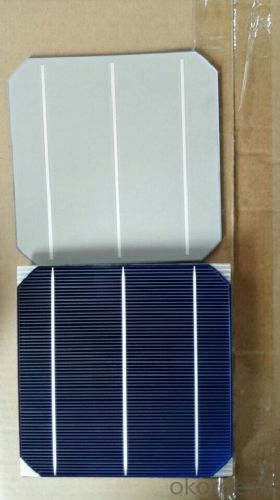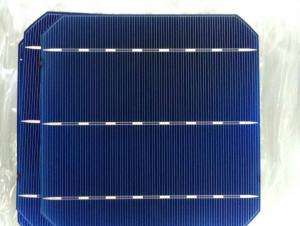Solar Cells Monocrystalline Silicon Solar Cell Price
- Loading Port:
- China Main Port
- Payment Terms:
- TT or LC
- Min Order Qty:
- -
- Supply Capability:
- -
OKorder Service Pledge
OKorder Financial Service
You Might Also Like
Quick Details
| Model Number: | monocrystalline solar cell 156x156 | ||||
| Material: | Monocrystalline Silicon | Size: | 156x156mm | Number of Cells: | 1 |
| Max. Power: | 4.6 | Color: | Blue | Main Bus bar: | 3BB |
| Grade: | B-Grade | Thickness: | 180/200 ± 20μm | Voltage: | 0.508V-0.53V |
| Efficiency: | 19.26% | Product: | In stock | Trade term: | Exw Shenzhen |
Packaging & Delivery
| Packaging Detail: | Neutral package |
| Delivery Detail: | 8-15 working days |
Specifications
1) Buy solar cells
2) mono solar cells
3) monocrystalline silicon solar cell price
4) Manufacturer Price


Most solar modules are currently produced from crystalline silicon (c-Si) solar cells made of multicrystalline and monocrystalline silicon. In 2013, crystalline silicon accounted for more than 90 percent of worldwide PV production, while the rest of the overall market is made up of thin-film technologies using cadmium telluride, CIGS and amorphous silicon Emerging, third generation solar technologies use advanced thin-film cells. They produce a relatively high-efficiency conversion for the low cost compared to other solar technologies. Also, high-cost, high-efficiency, and close-packed rectangular multi-junction (MJ) cells are preferably used in solar panels on spacecraft, as they offer the highest ratio of generated power per kilogram lifted into space. MJ-cells are compound semiconductors and made of gallium arsenide (GaAs) and other semiconductor materials. Another emerging PV technology using MJ-cells is concentrator photovoltaics (CPV).
- Q:Can solar cells be used in water heating systems?
- Yes, solar cells can be used in water heating systems. Solar thermal collectors, which use solar cells, can capture sunlight and convert it into heat energy to warm water. This technology is commonly used in solar water heating systems, where the heat generated by solar cells is transferred to water in order to provide hot water for various purposes.
- Q:Can solar cells be used in water desalination?
- Yes, solar cells can be used in water desalination. Solar-powered desalination plants use solar energy to power the desalination process, usually through the use of photovoltaic (PV) panels. These panels convert sunlight into electricity, which can then be used to power the desalination process, such as reverse osmosis or distillation. This approach offers a sustainable and environmentally friendly solution to meet the increasing water demands in water-scarce regions.
- Q:How do solar cells handle partial shading?
- Solar cells handle partial shading by using bypass diodes. These diodes allow the current to bypass the shaded area, ensuring that the rest of the solar cell continues to function efficiently. By redirecting the current, the solar cells can still generate power even if some parts are shaded, minimizing the impact of partial shading on overall performance.
- Q:Can solar cells be used in indoor applications?
- Yes, solar cells can be used in indoor applications, although their efficiency may be lower compared to outdoor use. Indoor applications typically include powering small electronic devices or providing lighting for indoor spaces.
- Q:Can solar cells be used for powering internet connectivity?
- Yes, solar cells can be used for powering internet connectivity. Solar cells generate electricity from sunlight, which can be used to power various devices, including routers, modems, and other networking equipment. This enables internet connectivity in remote areas where traditional power sources may not be available, making solar-powered internet an efficient and sustainable solution.
- Q:How do solar cells perform in different temperature ranges?
- Solar cells generally perform less efficiently at high temperatures. This is because the increase in temperature can lead to an increase in electron-hole recombination, reducing the overall photoelectric conversion efficiency. On the other hand, solar cells can also experience a decrease in performance at extremely low temperatures, although this effect is usually less significant. Overall, the efficiency of solar cells varies with temperature, with a decline at high temperatures and a smaller impact at low temperatures.
- Q:Can solar cells generate electricity at night?
- No, solar cells cannot generate electricity at night as they rely on sunlight to produce electricity.
- Q:How does solar cell technology apply to our daily life?
- It is used in different ways, such as electricity, water supply, etc.
- Q:How do solar cells perform in areas with high levels of air humidity?
- Solar cells generally perform slightly less efficiently in areas with high levels of air humidity. This is because the water molecules in the air can scatter and absorb some of the incoming sunlight, reducing the amount of light that reaches the solar cells. However, the impact of humidity on solar cell performance is generally minimal and can be compensated by using anti-reflective coatings or cleaning the panels regularly.
- Q:Are solar cells affected by shade?
- Yes, solar cells are affected by shade. Shade can significantly reduce the efficiency and output of solar cells. When solar cells are shaded, they receive less sunlight, which reduces the amount of energy they can convert into electricity. Therefore, it is important to ensure that solar panels are installed in a location where they receive maximum sunlight exposure throughout the day for optimal performance.
1. Manufacturer Overview |
|
|---|---|
| Location | |
| Year Established | |
| Annual Output Value | |
| Main Markets | |
| Company Certifications | |
2. Manufacturer Certificates |
|
|---|---|
| a) Certification Name | |
| Range | |
| Reference | |
| Validity Period | |
3. Manufacturer Capability |
|
|---|---|
| a)Trade Capacity | |
| Nearest Port | |
| Export Percentage | |
| No.of Employees in Trade Department | |
| Language Spoken: | |
| b)Factory Information | |
| Factory Size: | |
| No. of Production Lines | |
| Contract Manufacturing | |
| Product Price Range | |
Send your message to us
Solar Cells Monocrystalline Silicon Solar Cell Price
- Loading Port:
- China Main Port
- Payment Terms:
- TT or LC
- Min Order Qty:
- -
- Supply Capability:
- -
OKorder Service Pledge
OKorder Financial Service
Similar products
New products
Hot products
Hot Searches
Related keywords




























